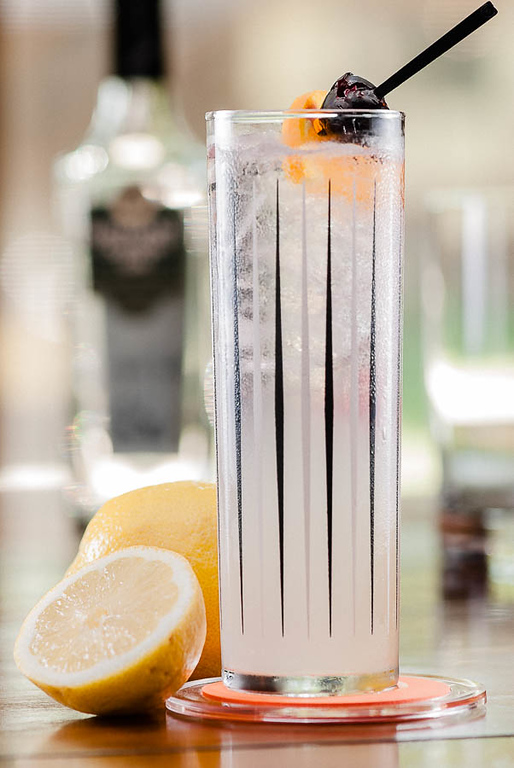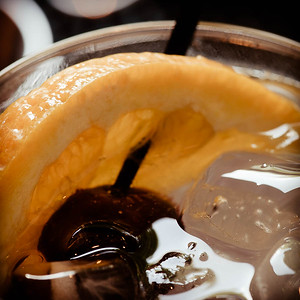It’s a sweltering hot afternoon. Dewpoint high enough to fog my glasses. And my work is done. Time for a Tom Collins.
I like this old classic. More refreshing than beer, lighter (and faster to make) than Mai Tais or Swizzles, the Tom Collins is a bright and simple refresher of gin, lemon, and soda.
Apparently it was once the fashion to mix the Tom Collins as an after dinner drink, a long, slow sipper that could be stretched through social evenings with gatherings of friends. (In 1941, Crosby Gage wrote that “It is in these after-dinner hours that the Highball, the Collins, the Rickey, the Gin and Tonic Water hold high place in millions of American homes.”) I think of them more as sunshine drinks, to be consumed when the day is long and the hot work done, the dinner hour distant, and cool refreshment and relaxation the new priorities of the day.
Though nearly every mixed drink these days is called a cocktail, the Collins is technically a separate drink, a subclass of the “sparkling sours” category, as Gary Regan call them (The Joy of Mixology, 2003.) You could think of the Tom Collins as a gin sour topped up with a healthy dollop of soda, and served in a tall glass. The “tall glass” presentation is arguably what makes the Collins a Collins, as it permits a large portion of soda compared to, say, the gin fizz, which is the same drink served in a smaller glass with considerably less soda, or the gin sour with no soda at all. The “Collins” glass itself has become stylized over the years; the modern Collins glass is typically taller and narrower than a standard tumbler.

Historians tell us that the Tom Collins likely descends from the gin punches that were ubiquitous in the 17th and 18th centuries; it is basically a very simple punch done up one glass at a time. (I recommend David Wondrich’s Imbibe! to all who are interested in the history.)
By the time Jerry Thomas’s editor added it to the posthumous edition of his Bartenders Guide in 1887, the formula was already pretty well set—a shot of spirits, fresh lemon juice and sugar, ice and soda. By then, the name “Tom Collins” had been freed of its strict association with gin punch, and now indicated a category that could accommodate gin, whiskey, or brandy.
By the mid-20th century, “Tom Collins” was again unequivocally a gin drink. The American whiskey version has become the John Collins, or sometimes the Colonel Collins. (The Genever version is also known as John Collins.) The obvious ethnic naming clichés abound: there is the Ivan Collins (vodka), the Jose Collins (tequila), the Mike Collins (Irish whisky), the Ron Collins (rum), and so forth. Very cute. My advice is to order the Tom Collins if you expect a London Gin Collins, and order anything else by the name of the spirit involved.
Here’s the basic Tom Collins recipe:
The Tom Collins
- 2 oz. London Dry gin (Bombay Dry, Beefeaters 24)
- 1 oz. fresh lemon juice
- ¾ oz. simple syrup (1:1)
- soda water to top
- cherry and orange for garnish
In the earliest days of the Tom Collins, the gin at hand would have been Old Tom or Genever. I tried the Old Tom styling, and while it is interesting as a way to understand the evolution of the Tom Collins, I will stick to the modernized London Dry formula as a brighter and more refreshing combination. Old Tom is sweeter than the London Drys, with a bit heavier mouth feel and less juniper; it might be a good choice if your lemons are unusually tart, as it seems to have a softening effect on the drink’s flavors. (The Old Tom available in my market is Hayman’s; other brands might produce a different result.)

There are a handful of useful variations you can make of the Tom Collins. The most obvious, and most likely to be required, is to adjust proportions to suit your mood and the pungency of your lemons. You can also experiment with gin types—the history of Tom Collins is a long experiment with gin fashions, from Genever to Old Tom to London dry, and there’s no reason not to try some of the less junipery, more botanical New Western Dry gins. I haven’t tried that experiment, but I would bet that citrus-friendly gins like New Amsterdam or the cucumber-heavy Hendrick’s could work very well as a base for Tom Collins.
If you want to punch up the flavor a bit, you could always try muddling the lemon peels with a bit of sugar to release some of the oils. And I’ve seen experiments with bitters, though this would remove us from the realm of the classic Collins, and start us on the slippery slope toward slings or swizzles. Not a bad idea, but not, strictly speaking, a Tom Collins, either.
“The Tom Collins Cocktail” at cold-glass.com : All text and photos Copyright © 2012 Douglas M. Ford. All rights reserved.

Nice post. We like the Hayman’s old tom gin in the collins quite a bit, but it is certainly not as crisp as a dry gin. But fun to play with these things…
Thanks. Sometimes I like Old Tom, sometimes not. I think that the hotter it gets, the more I enjoy the sharper London Dry mixture. Spring and Fall, Old Tom seems more attractive.
I was in a bar in London last year and they served me a gin sour but they called it a Tom & Jerry…I figured it was meant to be made with Old Tom given the name, though the bartender made it with London dry…Inspired, I tried it with Ransom Old Tom when I got home and it was really fantastic….Gin:lemon:syrup 5:2.5:1.5…So simple & so delicious—the Ransom has color unlike Hayman’s–I don’t recommend it in a Ramos gin fizz but it might be worth another try in the Tom Collins.
Tom and Jerry — a curious choice of names, given the famous pre-existing eggnoggy version. Anyway, I’d not thought of making a Tom Collins with Old Tom, and I have some Ransom sitting around doing nothing, so I think I’ll give that a try. Thanks!
Classic, stylish, refreshing. Fabulous choice!
Yes, I suppose the Tom Collins is just about as timeless as you can get.
Thanks for sharing this article!!! This is easily My all-time favorite cocktail!!!!! <3
Thanks for sharing this article!!! This is easily yy all-time favorite cocktail!!!!! When making this at home, I prefer to use No. 209 Gin. <3
Reblogged this on rabbits & foxes and commented:
I definitely want to share this article about the Tom Collins cocktail written by Douglas M Ford (Cold Glass). This is definitely an in-depth look into my all-time favorite cocktail. Seriously, this is by far, my most favorite shaken/stirred beverage…my idea of “liquid gold”. The recipe calls for London Dry gin, to shake your ingredients & garnish with an orange slice, but in my version of this delectable refreshment, I prefer No. 209 gin, to stir my ingredients & to add a wedge of lemon. (What can I say? I prefer a little tang in my drink.) Check it out & enjoy…
209 is a delightful gin; I’ve not used it in a Tom Colllins, but I expect it would be excellent. Thanks for the idea.
I’m with you with respect to the summer time associations of the drink. For me, it will be forever tied up with family holidays on Cape Cod, my mother, my aunt, smoking cigarettes and crisping up in the midday sun. Of course, the last two activities are severely frowned upon, as I suspect is that Collins mix they might have used when making the drink themselves…
Sounds like the Tom Collins was a well-loved drink in your family. Thanks for remembering a bit of the past for us.
I never thought this drink would have so much history to it. I usually enjoy it off a cocktail machine hire perth, without thinking of its origin. Thanks for the story, and the recipe!
Hi, Courtney, It’s interesting that simple drinks can have so much history. I’m glad you enjoyed the story.
There is no Tom Collins mentioned in Jerry Thomas’s 1876 edition of his book. Go look for yourself for free online and stop trusting these so called pretentious cockatil experts to give you facts. There is also no Collins mentioned in Steward and Barkeeper’s Manual of 1869 like Wondrich and other bloggers say. Again, look for yourself for free online. Tom Collins is mentioned in Jerry Thomas’s 1887 book. If you have proof Tom Collins apears in any print before 1887 than please prove it.
Hi, Jeremy, thanks for pointing the date discrepancy. I think I got my Thomas editions muddled. You’re right, the Tom Collins appears in the 1887 edition, as a sort of “family” of drinks all appearing under the same name (Tom Collins Whiskey, Tom Collins Gin, and so forth.) Good find; it’s curious that no one called this out before. I’ll update the text. Thanks!